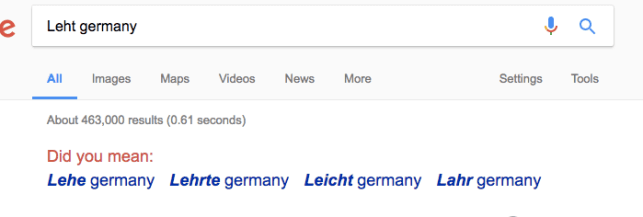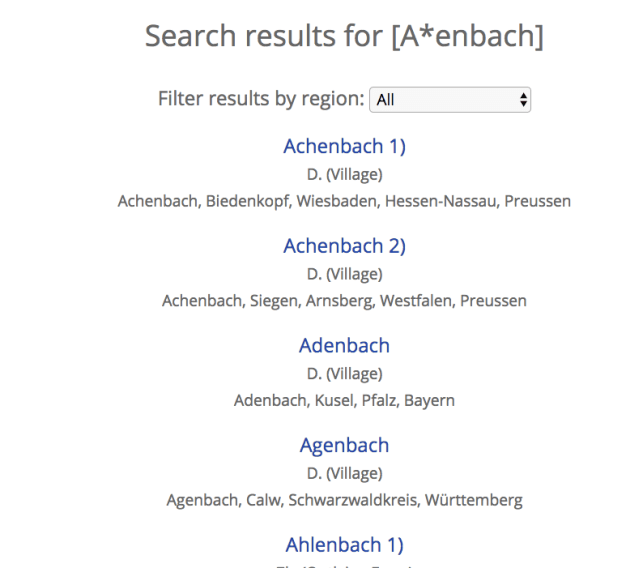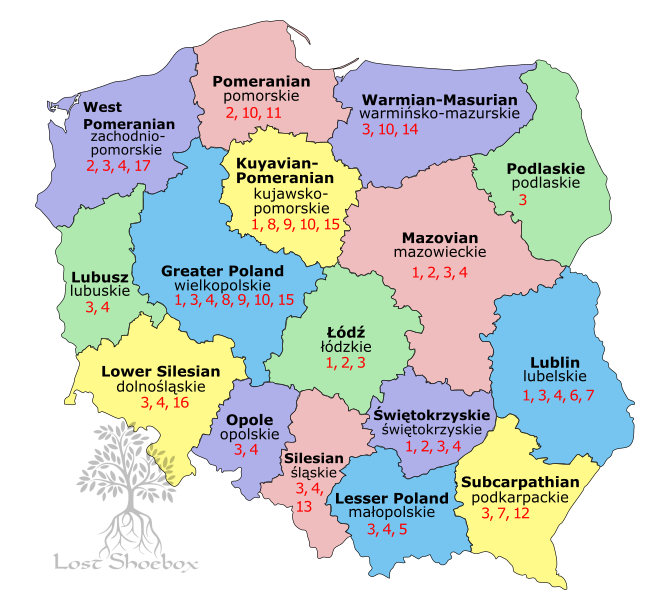by Sunny | Mar 21, 2018 | 01 What's New, German, Google, Maps, Translation tips
When you need help deciphering place names in hard-to-read genealogy documents, two free online tools may have great suggestions for you. Use them to take the guesswork out of identifying great-grandpa’s hometown!
Thanks to guest blogger Katherine Schober, expert German translator and author of the new book, Tips and Tricks of Deciphering German Handwriting, for this article on deciphering place names (or anything else) in hard-to-read old documents.
There are times when you know from the context of an old document that a certain handwritten word is a city or town–but you aren’t sure of the exact letters the scribe has written. Perhaps you can make out most of the name, but not the first letter. Or maybe you can’t tell whether you’re looking at an “r” or an “n” in the middle of the word. Other times, you can read the place name, but this particular spelling doesn’t appear on a map.
Deciphering place names with a simple trick—and 2 free online tools
Two online resources that are very helpful for identifying town names are Google’s search engine and Meyer’s Gazetteer. At both sites, you can enter what you do know and have these sites help suggest possible place names.
Google search suggestions
Type your transcribed town name into Google—along with any other known place clues, such as the county/province or country name–and see if you get any search results for the region you are researching. If you do, congratulations, you likely transcribed it correctly!
If not, Google may actually suggest the correct transcription of your word for you. For example, when I was translating a nineteenth-century document a few months ago, I read the letters of the town as “L-e-h-t”. I typed “Leht, Germany” into Google, and waited to see what search results would appear. As it turned out, there were no search results for “Leht, Germany,” but Google’s “Did you mean…” function actually provided four other possibilities for what I could have meant as a town name! Here’s what it gave me:

After comparing these Google suggestions with my handwritten word and the specific region of Germany, I realized that the word actually had an “r” and an “e” squeezed in and was, therefore, the German town of “Lehrte.” Taking advantage of this “Did you mean” feature of Google can be very helpful when trying to decipher city and town names.
(Learn hundreds more tips on using Google search–and all the other free Google tools–in Lisa Louise Cooke’s popular book, The Genealogist’s Google Toolbox.)
More help from Meyer’s Gazetteer
If you can only recognize the first few or the final few letters of a German town, Meyer’s Gazetteer is the site for you. Meyer’s Gazetteer is a free database containing names and information on pre-World War I German cities, towns, and villages (meaning that this site includes towns in present-day France, Poland, and other places). Type in the letters you recognize in your word and use an asterisk to represent the letters you don’t. Meyer’s Gazetteer will then provide you with a list of all places with your letter combination. Then you can then see if there is a town that matches your handwritten word and region.
In the example below, I recognized a capital “A” at the beginning of the word. The middle letters looked like a scribble, but I could see “e-n-b-a-c-h” as the final letters of the word. I typed this into Meyer’s Gazetteer, using an asterisk for those unclear middle letters. The website then provided me with a list of possibilities, and–by only looking at the town names in my specific German region–I was able to significantly narrow down what my handwritten town name could be. By comparing this list to my handwritten word, I was able to then decipher the remaining letters and figure out the name of the town. (Click here for more tips on using Meyer’s Gazetteer.)

By taking advantage of the resources available online, you can make your transcription process much easier and much more fun. Best of luck!
About the Author
Katherine Schober is a German translator who specializes in genealogy documents. Her new book, Tips and Tricks of Deciphering German Handwriting, is available in paperback or Kindle format. She also has a terrific German Handwriting Course here.
Check out Katherine’s other Genealogy Gems guest blog posts:
Disclosure: This article contains affiliate links and Genealogy Gems will be compensated if you make a purchase after clicking on these links (at no additional cost to you). Thank you for supporting Genealogy Gems!
by Lisa Cooke | Apr 15, 2017 | 01 What's New, German, Legacy Tree Genealogists, Maps |
Finding German hometowns can be challenging. Guest blogger Camille Andrus, a professional genealogist specializing in German research and Project Manager at Legacy Tree Genealogists shares 3 free German genealogy websites to put your ancestors on the map in the former German empire and modern-day Poland.

Map of German Reich 1871–1918. from kgberger, Creative Commons license, Wikipedia.com;
Anyone tracing German ancestors quickly finds themselves puzzling over maps in a region that has experienced a lot of change. Camille Andrus of Legacy Tree Genealogists recommends these 3 free German genealogy websites to help you navigate the former German empire–from Pomerania to Prussia to Poland. Here are her picks and her explanations for using them.
1. www.MeyersGaz.org
“For years, novice genealogists who found themselves embarking on the road of German genealogy were discouraged when needing to decipher an entry for their town in Meyers Orts- und Verkehrs-lexikon des deutschen Reichs (commonly known simply as Meyers or Meyer’s Gazetteer of the German Empire) due to the old German font in which the book was printed and the plethora of abbreviations that were used. To address this obstacle, the website www.MeyersGaz.org was created.
This online database not only explains the text and various abbreviations in the town entry that are found in the original printed version of Meyers, but also pinpoints the location of the town on both historic and modern maps, indicates the Catholic and Protestant parishes to which residents of the town would have belonged, and notes the distance from the town to all parishes within a 20-miles radius.
The database also allows users to search for a town using wildcards. This is especially useful when the exact spelling of a town is not known. For example, if the record on which you found the new town name indicated that the person came from Gross Gard…. where the second part of the word was smudged or illegible, you could simply put “Gross Gard*” into the database. In this case, the only two options would be Gross Garde in Pommern and Gross Gardienen in East Prussia. If you have a common town name such as Mülheim, you can filter the search results by province.”

Screenshot from MeyersGaz.org.
 Note: Genealogy Gems Premium website members can hear more about MeyersGaz on Premium Podcast episode 143.
Note: Genealogy Gems Premium website members can hear more about MeyersGaz on Premium Podcast episode 143.
2. Kartenmeister
“Kartenmeister is a database for towns which are found east of the Oder and Neisse rivers in the former German Empire provinces of East Prussia, West Prussia, Brandenburg, Posen, Pomerania, and Silesia. This area is now part of modern Poland. The database allows users to search for towns using either their German or Polish name.
Again, using Gross Gardienen as our example town, we learn that the Polish name for the town is now Gardyny and is located in the Warminsko-Mazurskie province. Like MeyersGaz.org, collaboration between users is encouraged. Individuals can enter their email address into a mailing list according to the town they are interested in and specify surnames they are researching in that town.”

3. Lost Shoebox

Map of Poland from Lost Shoebox shows where to find online records for each province.
“This website is an index to 17 websites focused on research in Poland. The list of websites corresponds with a map of Poland divided into its various modern provinces. Each number (representing a website) is listed on the map in each province for which it has records. Some websites are listed for nearly every province, while others show up for only one or two. The 17 websites featured on Lost Shoebox include either direct access to digital images, indexes to vital records, or lists of microfilms or other archival holdings.
If we were searching for records for Gross Gardienen or other nearby towns, we know from Kartenmeister that we would need to look in the Warminsko-Mazurskie province. The map shows the numbers 3, 10, and 14.” A corresponding key sends users to the appropriate websites.
“The third website on the list for the province brings us to the website for the Polish State Archive in Olsztyn. There are a plethora of digital images for both Evangelical church records and civil registration records available on this website.”
 Camille Andrus is a Project Manager for Legacy Tree Genealogists, a worldwide genealogy research firm with extensive expertise in breaking through genealogy brick walls. Her expertise includes Germany, Austria, German-speakers from Czech Republic and Switzerland and the Midwest region of the U.S., where many Germans settled.
Camille Andrus is a Project Manager for Legacy Tree Genealogists, a worldwide genealogy research firm with extensive expertise in breaking through genealogy brick walls. Her expertise includes Germany, Austria, German-speakers from Czech Republic and Switzerland and the Midwest region of the U.S., where many Germans settled.
Click here to learn more about Legacy Tree services and its research team











 Camille Andrus is a Project Manager for Legacy Tree Genealogists, a worldwide genealogy research firm with extensive expertise in breaking through genealogy brick walls. Her expertise includes Germany, Austria, German-speakers from Czech Republic and Switzerland and the Midwest region of the U.S., where many Germans settled.
Camille Andrus is a Project Manager for Legacy Tree Genealogists, a worldwide genealogy research firm with extensive expertise in breaking through genealogy brick walls. Her expertise includes Germany, Austria, German-speakers from Czech Republic and Switzerland and the Midwest region of the U.S., where many Germans settled.



